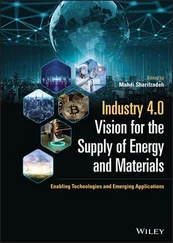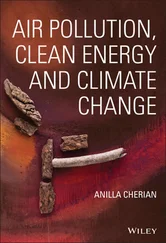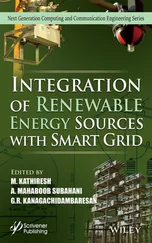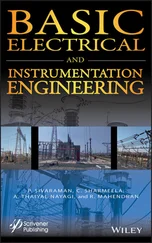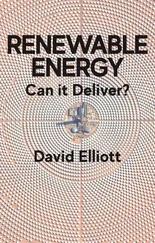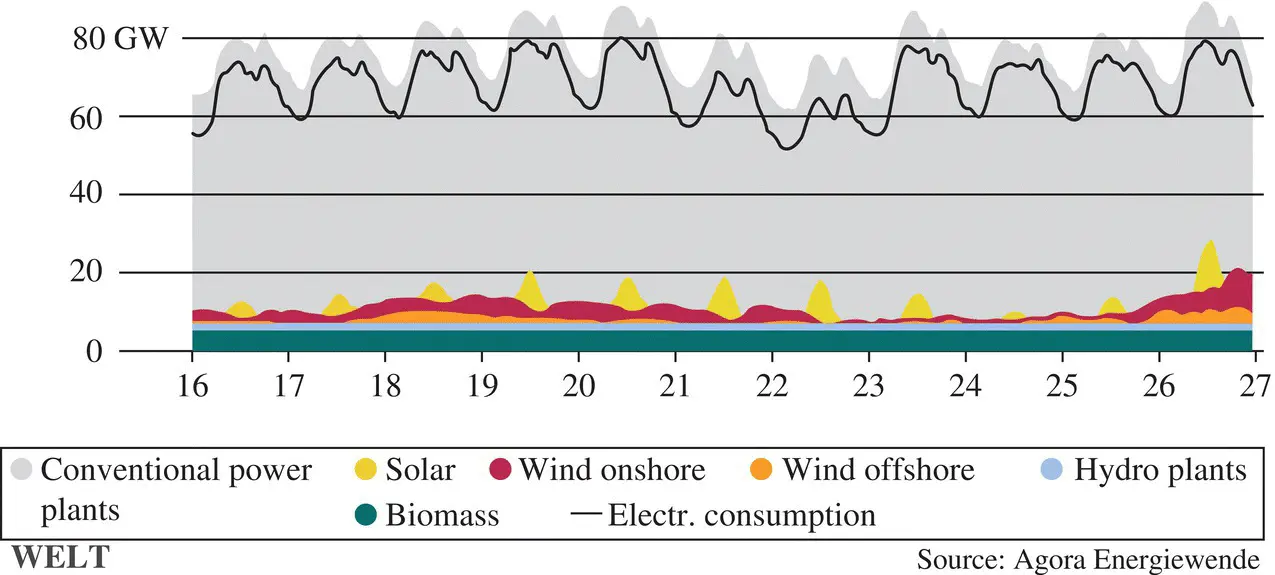
Figure P.5 Electric power (generation and consumption) requirements in Germany during 16–27 January 2017. The lightly‐shaded area, which exceeds the full line indicating consumption, represents generation, while the full line indicates consumption: generation = (consumption +losses), that is, generation > consumption.
During the period as indicated in Figure P.5, about 90% of the electric energy had to be provided by natural gas, coal, and nuclear power plants, the latter two of which are scheduled to be discontinued or decommissioned during the coming decade. Such a shutdown appears to be not prudent because short‐term (e.g. battery) and long‐term (e.g. pumped hydro) storage plants [8, 9] are unable to have an output power of 70 GW even only during a few days. Note that 70 GW is the power provided, for example, by either 35 nuclear and 70 coal or natural gas‐fired plants each having a rated output of 1 GW and 500 MW, respectively, or 300 hydro storage plants with each 233 MW output power rating. Clearly such a switch from conventional (e.g. coal, natural gas, nuclear) plants to storage plants appears to be not feasible. The transition from combustion engines (e.g. gasoline, diesel) to electric drives in automobiles, trucks, and trains will lead to significantly increased additional power consumption that cannot be provided by renewable energy during the times as indicated in Figure P.5. As a result, the strategy is to keep natural gas power plants each having an output of 200 MW operating together with some of the nuclear power plants that serve as a frequency leader. The supply of electric energy of Guangdong in southern China via high‐voltage DC (HVDC) lines led to a breakup [10] of the alternating current (AC) grid due to the lack of a frequency‐leading AC power plant and through the lack of sufficient reactive power to control voltage and frequency ( Figure P.6). It is well known that inverters converting direct current (DC) to AC at the point of common coupling (PCC) can supply reactive power only if the DC voltage at the DC input voltage of the inverters is significantly increased, as discussed in Chapters 10and 12. The renewable energy approach, where 100% of the energy is generated and transmitted via DC transmission lines, appears to be clearly too optimistic: there is indeed a climate dilemma.
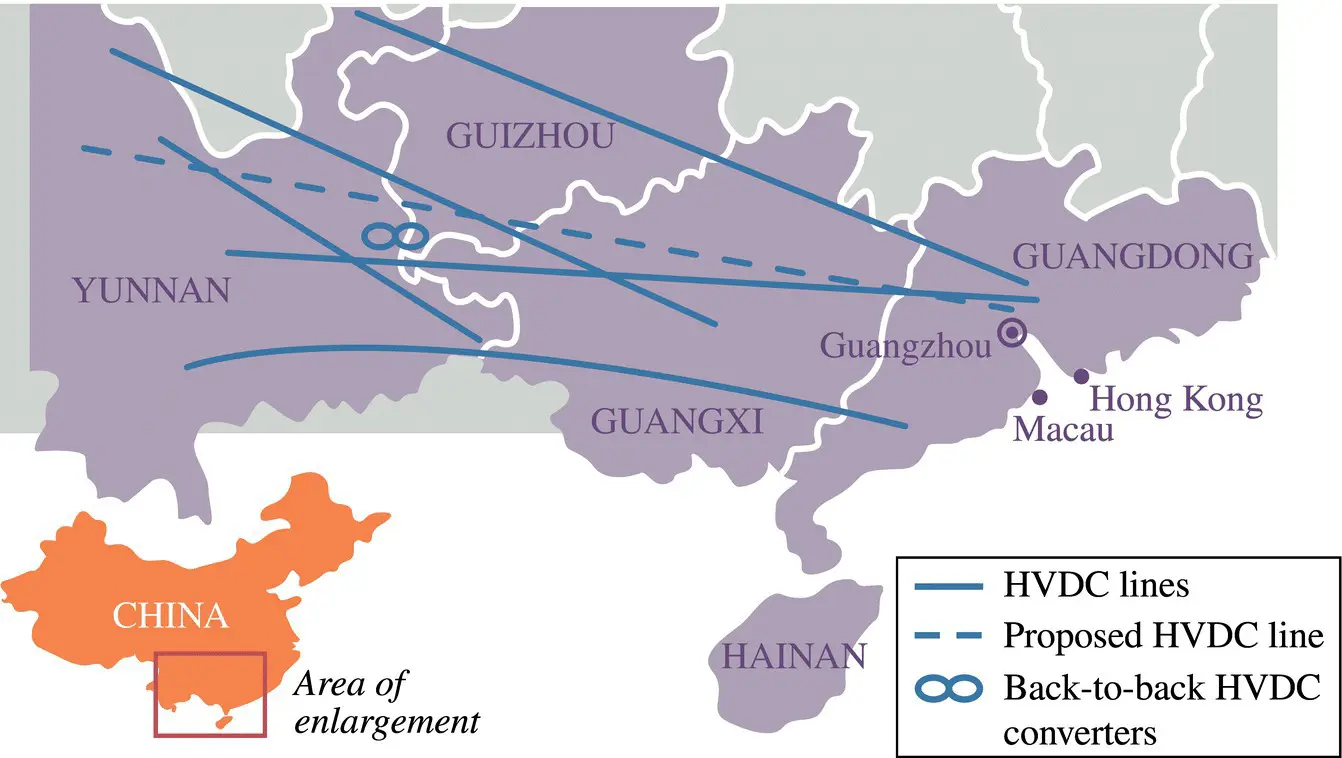
Figure P.6 The breakup of China's southern power grid due to the concentration of high‐voltage DC transmission lines in Guangdong, making the AC grid unstable.
P.2.2 Prerequisites for the Understanding of the Material as Offered in This Book
As a prerequisite to this effort, students must understand the following core competencies based on Applied Mathematics (APPM) 2350 Calculus III:
1 Single‐variable calculus (e.g. differentiation, integration),
2 Functions of several variables,
3 Vectors and vector operations,
4 Curves in space,
5 Multivariable functions,
6 Partial differentiation, multiple integrals,
7 Line integrals, e.g. Stokes' theorem and Gauss' theorem,
8 Complex numbers, complex calculus in Gaussian complex plane.
In summary, the intent of this text is to educate undergraduate students in non‐electrical engineering disciplines, physics, and chemistry as well as professionals in related fields who want to acquaint themselves in electrical engineering as applied to conventional and renewable energy.
1 NOAA (2014). Global climate report – January 2014. NOAA National Centers for Environmental Information, State of the Climate (published online February 2014). https://www.ncdc.noaa.gov/sotc/global/201401(accessed 31 May 2020).
2 Proxy (Indirect) Measurements. Data source: Reconstruction from ice cores. Credit: NOAA. https://climate.nasa.gov/vital‐signs/carbon‐dioxide(accessed 31 May 2020).
3 Hansen, J., Sato, M., Kharecha, P. et al. (2008). Target atmospheric CO2: where should humanity aim? Open Atmospheric Science Journal 2: 217–231. https://doi.org/10.2174/1874282300802010217.
4 Tans, P. and Keeling, R. http://www.c2es.org/content/main‐greenhouse‐gases(accessed 31 May 2020).
5 Koningstein, R. and Fork, D. (2014). Energy's creative destruction. IEEE Spectrum (December 2014): 26–31.
6 ntv.de, kst (2017). Kohlekraft muss einspringen Dunkelflaute zeigt Makel des Ökostroms. Foto: picture alliance/dpa. https://www.n‐tv.de/wirtschaft/Dunkelflaute‐zeigt‐Makel‐des‐Okostroms‐article19691796.html(accessed 31 May 2020).
7 Wetzel, D. (2017). Die “Dunkelflaute“ bringt Deutschlands Stromversorgung ans Limit. https://www.welt.de/wirtschaft/article161831272/Die‐Dunkelflaute‐bringt‐Deutschlands‐Stromversorgung‐ans‐Limit.html(accessed 31 May 2020).
8 Fuchs, E.F. and Masoum, M.A.S. (2011). Power Conversion of Renewable Energy Systems, 2nd Printing. New York: Springer 692 pp.
9 Masoum, M.A.S. and Fuchs, E.F. (2008). Power Quality in Power Systems and Electrical Machines, 2e. Amsterdam: Academic Press/Elsevier 1123 pp.
10 Fairley, P. (2016). Why Southern China broke up its power grid. IEEE Spectrum (December 2016): 13. 14.
Glossary of Symbols, Abbreviations, and Acronyms
A
aarmatureaaverage term of Fourier analysisaℓ + 1/2area of quadrilateral (one irregular third) of triangular mesh  = 3aℓ + 1/2area of triangular meshAappliances, forcing term, unit of ampere, cross section of magnet, ampereAℓvector potential at node ℓAovector potential at node oA3constantAccross section of iron coreAgcross section of air gap of an iron coreAvopen‐loop voltage gainA, B, Cphase sequence A, B, C of line A, line B, and line Cab(voltage) from a to bAB(voltage) from line A to line Ba, b, cphase sequence lines a, b, cACalternating currentancoefficient of Fourier term ancos nωtanphase a (a) to neutral (n)anrmsphase a (a) to neutral (n) root‐mean‐square (rms) valueAPPMapplied mathematicsASICapplication‐specific circuitAWGAmerican wire gaugealphafiring angle α of thyristor bridgeαdamping factor/coefficient, angle∠ − 90 ° = e−j90°angular displacement/shift of time function∠θvindicates phase shift voltage v(t) by either θv degrees (°) or θv radians (rad)
= 3aℓ + 1/2area of triangular meshAappliances, forcing term, unit of ampere, cross section of magnet, ampereAℓvector potential at node ℓAovector potential at node oA3constantAccross section of iron coreAgcross section of air gap of an iron coreAvopen‐loop voltage gainA, B, Cphase sequence A, B, C of line A, line B, and line Cab(voltage) from a to bAB(voltage) from line A to line Ba, b, cphase sequence lines a, b, cACalternating currentancoefficient of Fourier term ancos nωtanphase a (a) to neutral (n)anrmsphase a (a) to neutral (n) root‐mean‐square (rms) valueAPPMapplied mathematicsASICapplication‐specific circuitAWGAmerican wire gaugealphafiring angle α of thyristor bridgeαdamping factor/coefficient, angle∠ − 90 ° = e−j90°angular displacement/shift of time function∠θvindicates phase shift voltage v(t) by either θv degrees (°) or θv radians (rad)
Bboron, base, flux density, susceptance, viscous or fluid friction coefficientB(t)magnetic flux density as a function of time  magnetic flux density vector
magnetic flux density vector  magnitude of magnetic flux density vectorBmsusceptance of main (m) winding of transformerB1constantB2constantBgmagnetic flux density within air gapBϕmagnetic field density component in Φ direction of (r, Φ, z) coordinate systemBϕ (r)magnetic field density component in Φ direction as a function of r coordinate of (r, Φ, z) coordinate systemBW = 1/RCbandwidthbatbatteryBearthmagnetic DC field density of Earth caused by north and south poles of Earthbncoefficient of Fourier term bnsin(nωt)bnphase b (b) to neutral (n)Bϕ_inmagnetic field density component in Φ direction inside of round wireBϕ_outmagnetic field density component in Φ direction outside of round wireB‐HB‐H characteristicBMWBayerische Motoren Werke AGbpmbeats per minuteBJTbipolar junction transistorBWbandwidth of resonant circuitβangle
magnitude of magnetic flux density vectorBmsusceptance of main (m) winding of transformerB1constantB2constantBgmagnetic flux density within air gapBϕmagnetic field density component in Φ direction of (r, Φ, z) coordinate systemBϕ (r)magnetic field density component in Φ direction as a function of r coordinate of (r, Φ, z) coordinate systemBW = 1/RCbandwidthbatbatteryBearthmagnetic DC field density of Earth caused by north and south poles of Earthbncoefficient of Fourier term bnsin(nωt)bnphase b (b) to neutral (n)Bϕ_inmagnetic field density component in Φ direction inside of round wireBϕ_outmagnetic field density component in Φ direction outside of round wireB‐HB‐H characteristicBMWBayerische Motoren Werke AGbpmbeats per minuteBJTbipolar junction transistorBWbandwidth of resonant circuitβangle
Читать дальше
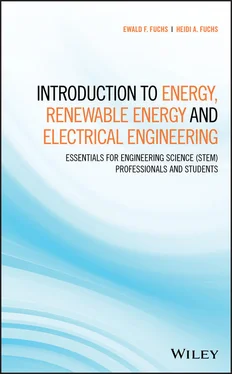


 = 3aℓ + 1/2area of triangular meshAappliances, forcing term, unit of ampere, cross section of magnet, ampereAℓvector potential at node ℓAovector potential at node oA3constantAccross section of iron coreAgcross section of air gap of an iron coreAvopen‐loop voltage gainA, B, Cphase sequence A, B, C of line A, line B, and line Cab(voltage) from a to bAB(voltage) from line A to line Ba, b, cphase sequence lines a, b, cACalternating currentancoefficient of Fourier term ancos nωtanphase a (a) to neutral (n)anrmsphase a (a) to neutral (n) root‐mean‐square (rms) valueAPPMapplied mathematicsASICapplication‐specific circuitAWGAmerican wire gaugealphafiring angle α of thyristor bridgeαdamping factor/coefficient, angle∠ − 90 ° = e−j90°angular displacement/shift of time function∠θvindicates phase shift voltage v(t) by either θv degrees (°) or θv radians (rad)
= 3aℓ + 1/2area of triangular meshAappliances, forcing term, unit of ampere, cross section of magnet, ampereAℓvector potential at node ℓAovector potential at node oA3constantAccross section of iron coreAgcross section of air gap of an iron coreAvopen‐loop voltage gainA, B, Cphase sequence A, B, C of line A, line B, and line Cab(voltage) from a to bAB(voltage) from line A to line Ba, b, cphase sequence lines a, b, cACalternating currentancoefficient of Fourier term ancos nωtanphase a (a) to neutral (n)anrmsphase a (a) to neutral (n) root‐mean‐square (rms) valueAPPMapplied mathematicsASICapplication‐specific circuitAWGAmerican wire gaugealphafiring angle α of thyristor bridgeαdamping factor/coefficient, angle∠ − 90 ° = e−j90°angular displacement/shift of time function∠θvindicates phase shift voltage v(t) by either θv degrees (°) or θv radians (rad) magnetic flux density vector
magnetic flux density vector  magnitude of magnetic flux density vectorBmsusceptance of main (m) winding of transformerB1constantB2constantBgmagnetic flux density within air gapBϕmagnetic field density component in Φ direction of (r, Φ, z) coordinate systemBϕ (r)magnetic field density component in Φ direction as a function of r coordinate of (r, Φ, z) coordinate systemBW = 1/RCbandwidthbatbatteryBearthmagnetic DC field density of Earth caused by north and south poles of Earthbncoefficient of Fourier term bnsin(nωt)bnphase b (b) to neutral (n)Bϕ_inmagnetic field density component in Φ direction inside of round wireBϕ_outmagnetic field density component in Φ direction outside of round wireB‐HB‐H characteristicBMWBayerische Motoren Werke AGbpmbeats per minuteBJTbipolar junction transistorBWbandwidth of resonant circuitβangle
magnitude of magnetic flux density vectorBmsusceptance of main (m) winding of transformerB1constantB2constantBgmagnetic flux density within air gapBϕmagnetic field density component in Φ direction of (r, Φ, z) coordinate systemBϕ (r)magnetic field density component in Φ direction as a function of r coordinate of (r, Φ, z) coordinate systemBW = 1/RCbandwidthbatbatteryBearthmagnetic DC field density of Earth caused by north and south poles of Earthbncoefficient of Fourier term bnsin(nωt)bnphase b (b) to neutral (n)Bϕ_inmagnetic field density component in Φ direction inside of round wireBϕ_outmagnetic field density component in Φ direction outside of round wireB‐HB‐H characteristicBMWBayerische Motoren Werke AGbpmbeats per minuteBJTbipolar junction transistorBWbandwidth of resonant circuitβangle